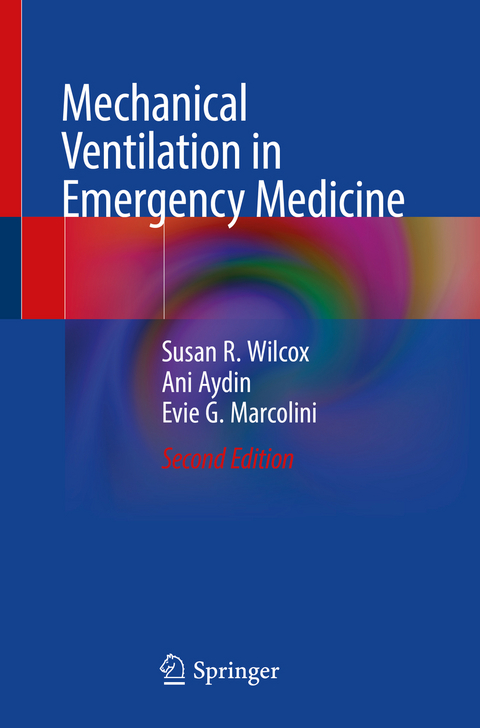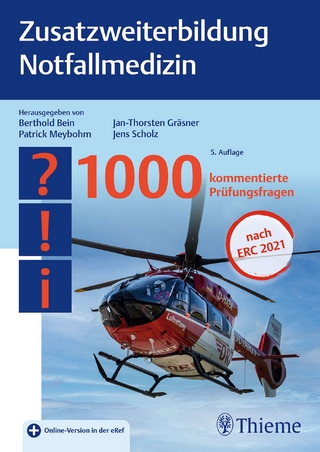
Mechanical Ventilation in Emergency Medicine
Springer International Publishing (Verlag)
978-3-030-87608-1 (ISBN)
This book functions as both an introduction and a refresher of fundamental mechanical ventilation concepts. It reviews the core evidence-based principles of ventilation and focuses on this topic as it occurs in the emergency setting, covering the management from intubation until transfer to the ICU.
Comprehensive and concise, this second edition features updated new material on blood gas analysis, advanced modes of ventilation, as well as a completely revamped chapter on the ventilator screen, and five new case studies. Additionally, many of the expertly written chapters are supplemented with illustrations crafted for quick, visual learning.
Written with the daily challenges of the emergency room in mind, Mechanical Ventilation in Emergency Medicine, Second Edition, is an invaluable reference for all emergency health care providers.
Susan R. Wilcox, MD, FACEP, FCCM
Chief, Division of Critical Care
Department of Emergency Medicine
Heart Center ICU
Massachusetts General Hospital
Assistant Professor, Harvard Medical School
Ani Aydin, MDAssistant Professor
Yale School of MedicineDepartment of Emergency Medicine and Department of Surgery, Division of General Surgery, Trauma and Surgical Critical Care New Haven, CT
Evie G. Marcolini, MDAssistant Professor
Geisel School of Medicine at DartmouthEmergency Medicine and Neurocritical CareHanoverNew Hampshire USA
Notes: New material in bold
Introductiona.Goals of this text The purpose of this section is to introduce the reader to the simplified style of this text.b.Goals of Mechanical Ventilation in the EDBy including a section on the goals of ventilation in the ED, we intend to impress upon any reader how important this topic is in the care of their patients and encourage motivation for reading it in its entirety. 2.Terminology and DefinitionsIn our experience, people new to mechanical ventilation find the terminology confusing and intimidating. Therefore, rather than have a glossary at the end of the book, we moved the definitions to the front. By defining the terms initially, then using them consistently, we are using repetition and clarity to improve learning. a.Ventilator Basicsb.Physiology Termsc.Phases of Mechanical Breathingd.Ventilator Settingse.Ventilator Modes3.Review of Physiology and PathophysiologyPhysiology may be rather tedious to some readers, but our intent with this section is to explain the "why" behind much of the management of the ventilator. To improve learning and prevent large sections of text, we use numerous illustrations to highlight each principle. a.Gas Exchangeb.Compliance c.Resistanced.Atelectasise.Air-trapping4.Blood Gas Analysisa.Venous vs arterial blood gasesb.Indications for blood gasesc.Interpretation of acid-based.Interpretation of oxygenation5.Modes of VentilationIn this section, we address the interactions of the ventilator with the patient. We highlight the indications and contraindications for each mode. We selected modes that clinicians in the ED are likely to encounter and did not include any more esoteric modes. a.Non-Invasive Ventilationi.CPAPii.BPAPb.Invasive Ventilationi.Assist Controlii.SIMViii.Pressure Supportiv.Advanced Modes6.Pressures on the VentilatorThis section describes the pressures set and received on the ventilator and why they are clinically important in the ED. While there are many possible pressures and parameters we could have mentioned, we deliberately chose these as they are most pertinent to the care of the ED patient. a.Peak Inspiratory Pressureb.Plateau Pressurec.AutoPEEP7.Understanding the Ventilator Screen In this section, the reader has an opportunity to put together all the information from the prior sections and focus on clinically important skills in reading a ventilator screen. We use illustrations similar to many common ventilator types to provide a broad array of examples and rely heavily on the self-quiz mode of teaching in this section. (Note: we plan to rewrite this chapter substantially from the First Edition, using all new images and examples)8.Setting the VentilatorThis section reviews the basic concepts behind selecting ventilator settings for all patients, drawing upon the previously discussed information9.Specific Circumstances: Acute Respiratory Distress SyndromeAs ARDS has a wealth of data supporting the importance of good ventilator management, we focus on evidence-based medicine in this chapter. We discuss low-tidal volume ventilation, monitoring of plateau pressure, and describe the management of refractory hypoxemia in the ED. Will specifically address the newest literature on NMB in ARDS.10.AsthmaIntubation of asthmatics in the ED is a high-risk procedure, due to the complications from poor ventilator management. In this section, we illustrate proper management and reinforce key physiologic principles. 11.COPDPatients with COPD are similar to asthmatics, but management of their ventilation has some differences. We highlight these differences in this section. 12.Traumatic Brain InjuryImproper ventilation management has been associated with worse outcomes in patients with TBI. This section addresses the most evidence-based approach for caring for these patients. 13.Troubleshooting the Mechanically Ventilated PatientMechanically ventilated patients are at high risk of deterioration and complications in the ED, and many clinicians are uncertain of how to respond to alarms or deterioration. We provide a simple framework for troubleshooting complications of ventilation. a.DOPESb.DOTTSc.High Pressure Alarmd.Low Pressure Alarm14.Case Studies in Mechanical Ventilation in Emergency MedicineWill provide 5 all-new case studies in the same format as the prior edition. 15.Conclusions and Key ConceptsWe finish the text with a summary, reinforcing key ideas from the text to maximize repetition and future recall.
| Erscheinungsdatum | 23.11.2021 |
|---|---|
| Zusatzinfo | VII, 111 p. 77 illus., 68 illus. in color. |
| Verlagsort | Cham |
| Sprache | englisch |
| Maße | 155 x 235 mm |
| Gewicht | 195 g |
| Themenwelt | Medizin / Pharmazie ► Medizinische Fachgebiete ► Notfallmedizin |
| Schlagworte | Acute respiratory distress syndrome in the ED • Asthma management in the emergency department • Chronic obstructive pulmonary disease in the ED • critical care • Emergency Medicine • Mechanical ventilation in emergency settings • Mechanical ventilation in the emergency department • Mechanical ventilators • Respiratory failure in the emergency department • Traumatic brain injury in the emergency department |
| ISBN-10 | 3-030-87608-X / 303087608X |
| ISBN-13 | 978-3-030-87608-1 / 9783030876081 |
| Zustand | Neuware |
| Haben Sie eine Frage zum Produkt? |
aus dem Bereich


